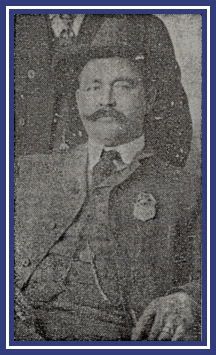Buster Wainscott, Horse Thief

Alfred Lund - 1903
During the four years from 1897 to 1901, Deputy Sheriff Alfred Lund of Kay County, encountered many kinds of criminals. In one of these encounters, he chose a unique way of capturing a horse thief named Buster Wainscott in the Osage Nation.
At the time the Osage Nation was under the jurisdiction of Kay County for certain official business. Deputy Lund, with a warrant in his hand, hitched a team and drove to Ponca City, where he borrowed a saddle and rode one of the horses, while trailing behind the other, about 30 miles into Osage county, where Wainscott was reported to be staying with a rancher named Sparks.
When he arrived within a half mile of the ranch, Lund tied the horses to a tree and hid, watching the entrance to the ranch house. About sunset a man came out of the house and started for one of the feed shacks. Lund, who was unable to see the man clearly, ordered him to throw his hand up, covering him with his rifle. He proceeded towards him and when he got close, Lund knew it wasn't his man.
He introduced himself to this person, who was the owner of the ranch and a short conversation revealed that the man had known Lund in Kansas at a younger age.
"Aren't you the kid?" asked Sparks.
Lund replied that he was. When he was a young man in Kansas, he had worked on many ranches, and because of his age, he was known as the "kid" by many of the surrounding ranchers and cowhands.
In the conversation Lund learned that Wainscott was indeed staying at the ranch, but was attending a dance a few miles from the ranch. He soon developed a plan.
In those days, it was a common practice for cowboys to share bunks if there wasn't enough to go around. Lund reasoned that Wainscott wouldn't be suspicious if he were to be in the bunk when the outlaw returned. So he informed Sparks of his plan and retired to the bunkhouse. Inside, he looked over the situation and decided to remove the lamp so Buster couldn't see him that well. Locating his bunk, Lund made himself comfortable.
Wainscott returned to the bunkhouse at about 4 a.m. The Rancher, Sparks, was waiting and informed Buster another cowboy would be doubling up with him. Looking at Lund, Wainscott said, "He looks clean enough.", took off his gun belt and shirt, placing his pistol under the pillow and went to sleep. While he was asleep, Lund removed his gun.
Lund got up just before dawn and ate breakfast with Sparks in the bunkhouse. After thanking him for a fine meal, he commented, "Well, I guess it's about time to wake up Buster." Lund walked over to where the outlaw was fast asleep and shook him. Wainscott, awakening and seeing Lund, immediately went for his gun. It was gone.
"Well I guess you got me this time." spoke the disappointed outlaw. Lund put Buster on a horse, shackled his legs beneath the animal, and brought him back to face his warrant in Kay County.
Buster Wainscott was tried and convicted of horse stealing, given 6 months in the federal jail in Guthrie. County Sheriff Pierce along with Deputy Lund transported Buster on the next train out. Depositing Buster with the local federal jailor, Wainscott spoke these choice words, "I will be back."
True to his word, after serving his time, he made his way back to Kay County. Here, along with a partner, they became a menace to the law abiding citizens of several communities. He was wanted for hog stealing, cattle stealing, resisting arrest and other minor offenses and all sort of warrants were out for his arrest. Wainscott had fun with Ponca City officers and given it out that he would be a hard man to take. Lund soon took to his trail and had just missed locating him on several occasions. On June 17, 1900, he didn't have to wait any longer because Buster came to him.
Deputy Lund along with newly elected City Marshal E.E. Stephenson, learned that Wainscott was seen in their home town of Blackwell. They kept a sharp lookout for him during the night, but couldn't locate him. At about daylight he was seen again in the southwest part of town in the company of Anna Roe, a soiled dove. The officers were notified and went out in that part of town and found their tracks coming towards the center of town. Tracking them the officers found that they separated. The female going down Blackwell Avenue, Wainscott going into the Red Front Livery Barn.
After entering, Wainscott saw Lund and made a run for it. Lund ordered him to halt and throw up his hands, but Buster answered by drawing his gun. At this, City marshal Stephenson let him have a load of buckshot in the legs, which brought him down. He started to raise his revolver again when Deputy Lund approached where he laid and confronted him with a Winchester, which he concluded to submit to be disarmed.
The officer carried him to the office of Dr. Lowery and had his wounds dressed. About a dozen shots entered his hip and legs, but the wounds were not considered dangerous. Afterward he was removed to Hotel Blackwell where he was put under watch till he could be transported to Newkirk and the county jail.
Rumors soon were started that Wainscott's partner was soon to rescue him. In the Blackwell Kay Sun, on June 21, 1900, Deputy Lund sent this man a very special message. He stated, "If he don't want captured or have his hide punctured, he better stay away from Blackwell because our officers have instructions to shoot first and apologize afterward." No rescue was made.
|












